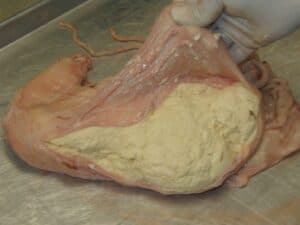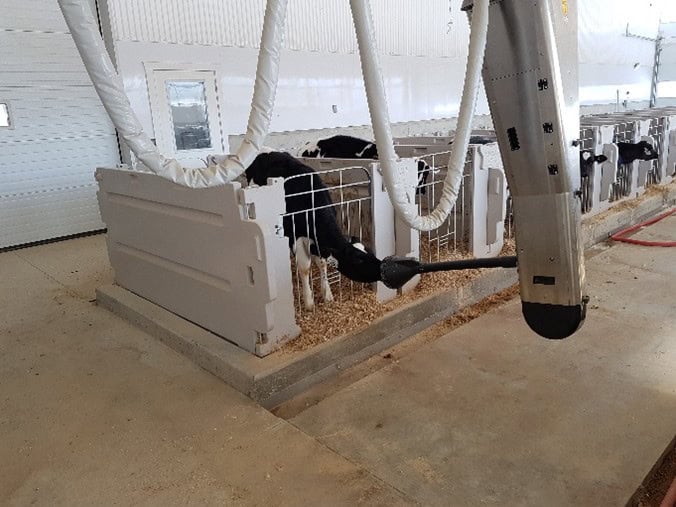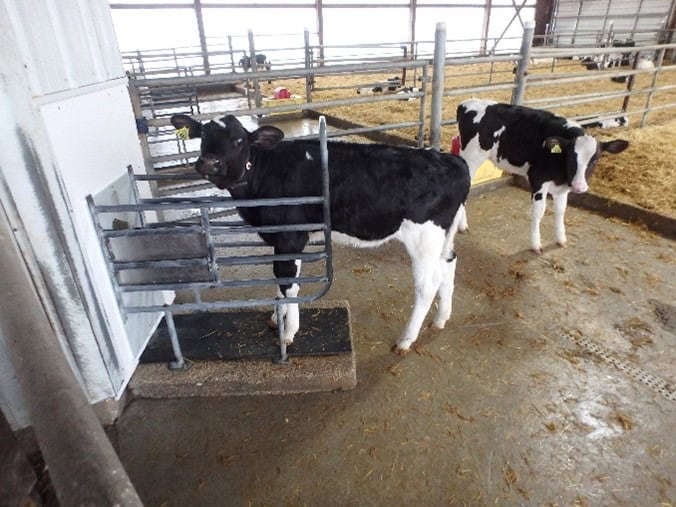Discover the truth about ad libitum and 40FIT calf feeding plans. This post clears up common misconceptions and explains how automated feeders can support natural calf behavior, improve growth, and optimize early-life nutrition.
Misconceptions about Ad libitum or 40FIT Feeding Plans for Your Calves
Traditionally we have fed calves twice a day limited amounts of milk or milk replacer (2 quarts or liters/meal). The logic was that the young animal had a limited gut capacity.
Let’s look at the biology of this young calf. The picture below is the abomasum of a Jersey calf that is several days old, showing the milk clot. Size of the organ can be referenced by the size of the hand.

The calf may have been tube fed 2 to 4 L of colostrum for its first meal and is making the transition from colostrum to milk or milk replacer.
Now, what’s the “normal” feeding behavior of the newborn or very young mammal. The newborn gets that first meal at various intervals after being born. There is quite a bit of variation in time to first feeding, the size of that meal and the interval between meals. Generally, meals are frequent (> 5x/day) and increasing in size of the meal and the total amount of milk consumed per day as the animal ages. Now apply this to how we have traditionally fed calves housed individually and fed with bottles! Quite a bit of difference, right?
Optimizing biology with the calf autofeeder!
Remember “normal” biology! The first few days feeding calves individually with a bottle is advantageous as we can observe them closely and address any problems which might arise. However, the best advice on managing calves with the autofeeder system is to place them onto the autofeeder as soon as they have a vigorous appetite! Two options exist here – the CalfRail or the group pen with an autofeeder. Both can be very successful when managed correctly. The goal should be to place them on the autofeeder by 3 to 7 days of age!


It’s tempting to delay, but what this does is lose the benefits of the autofeeder system. Why so early?
- Research with autofeeders shows that the feeding behavior of calves varies tremendously in daily intake, feeding frequency and meal size. A one size approach does not suit all calves due to variability in birth weight, health, genetics, and environment.
- Calves don’t need to consume large meals to achieve desired intake of milk for desired growth during early life when starter intake is minimal.
Achieving “normality” in feeding behavior
- Let calves eat to appetite but limit how much they can consume during one visit to the autofeeder station or CalfRail. This mimics “normal” nursing behavior of mammals.
- Calves achieve more relaxed behavior compared to those calves fed twice a day from bottle or bucket.
- The autofeeder accommodates variation in feeding behavior of calves. Research has shown that some calves will consume far more milk than others, but that most calves will establish their own unique feeding behavior which the autofeeder can accommodate.
Cost considerations
- One of the greatest benefits of the autofeeder is that it’s possible to achieve more growth during early life when starter intake is minimal. This results in greater feed efficiency and less cost/unit of gain as a greater proportion of the daily milk intake can support growth vs. maintenance.
- How long to allow ad libitum milk intake? In the European countries it is more common to feed milk ad lib longer – 40 days as compared to the North American farms. This is the source of the term 40FIT.
- Whichever length of ad lib feeding is chosen; the principles of the next phase are similar. There are two options to consider here.
- Staged weaning – post 40FIT or ad lib
- Reduce milk allotment from ~ 12 L to 8L over 4 days. Some farms may select a lower number of 7 or 6L/day. This stimulates calf starter intake!
- Hold daily allotment at this lower number for ~ 10 days.
- Last 14 days decrease the daily allotment from the previous number to 2L.
- Gradual weaning
- After the initial 40FIT or ad lib period gradually reduce milk from 12 L to 2 L over ~ 28 days.
- Generally, this option is less stimulatory for starter intake but both options can be successful.
One special consideration. The CalfRail system obviously does not allow milk consumption upon demand. However, most systems are set up to permit ~ 5 meals per day when the nipple is presented to the calf. Typical meal sizes are ~2L.
Summary – Correcting misconceptions about the 40FIT or ad lib feeding options for autofeeders.
- High milk intake causes digestive problems. The autofeeder permits feeding more nutrients in smaller, more frequent meals which are similar to mammalian nursing behavior. There’s bound to be some stress in bottle fed calves consuming ~4 quarts or more / feeding.
- Calves will overeat and become obese. The efficiency of growth early in the calf’s life is very high. Intake is limited by transitioning to restricted milk intake before over fattening becomes an issue.
- High milk feeding discourages starter intake. Actually, the autofeeder calves are larger earlier in life and then milk feeding can be limited to encourage starter intake.
- It is too expensive to feed so much milk. Milk intake early in life is encouraged resulting in better early growth and improved feed efficiency and lower cost/unit of gain. Conventional systems where all calves receive the same meal until just prior to weaning are less efficient as starter intake may be delayed.
- The autofeeder can replicate “normal” mammalian early feeding behavior. Granted dairy systems wean calves earlier than beef systems.
- Autofeeder systems encourage disease spread. It’s obvious that calves will share nipples. Automated systems exist to clean nipples between calves, but there is nose to nose contact of calves in group pen systems. However, have we considered potential stress of housing calves separately and feeding them only twice daily? What is the sanitation of bottles and especially buckets in conventional feeding systems?
- High milk intakes cause abnormal behaviors. Actually, the bottle-fed calves exhibit far more non-nutritive sucking. In fact, autofeeder systems should deliver more than 8L / day during the first month to discourage cross sucking. Higher milk intake of autofeeder systems encourages more contentment and resting.
- All calves should be fed the same way. A one size fits all approach does not suit every calf. The autofeeder system can accommodate individuality and an environment for calves to thrive.
The 40FIT or ad lib feeding program does not “force” the calf to drink large quantities of milk at one time or at one meal!

